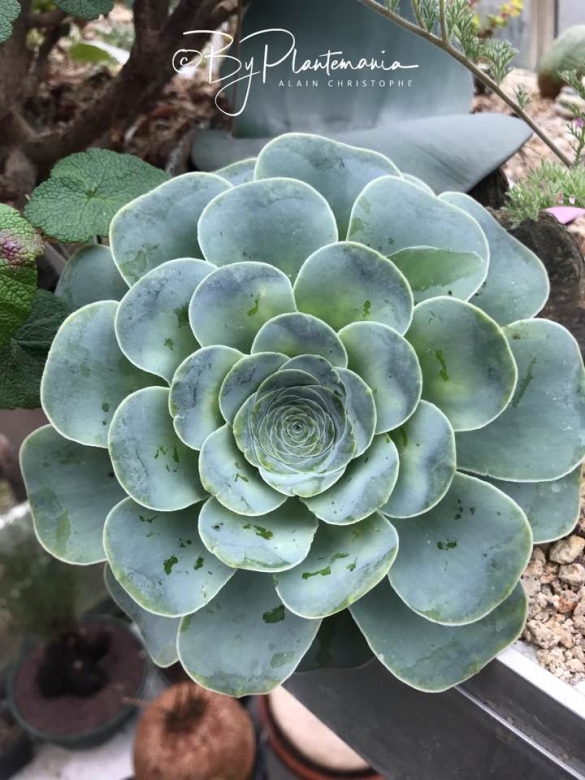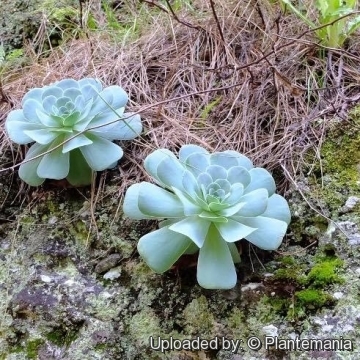
Aeonium aureum Photo by: © Plantemania
Origin and Habitat: Canary Islands (Gran Canaria, Tenerife, Gomera, La Palma, Hierro, with the exception of Lanzarote and Fuerteventura).
Altitude range: It occurs at altitudes from 400 to 2000 metres above sea level.
Habitat and ecology: Aeonium aureumSN|34754]]SN|34754]] forms rather large tufts in habitat. As a location cliffs and rooftops are preferred.
Synonyms:
See all synonyms of Aeonium aureum
back
Accepted name in llifle Database:Aeonium aureum (C.Sm. ex Hornem.) T.MesEvol. Syst. Crassulaceae 41 1995.Synonymy: 9
back
Description: Aeonium aureumSN|34754]]SN|34754]] (Greenovia aureaSN|34755]]SN|34755]]) is a monocarpic perennials succulent plant that forms a dwarf prostrate, clump that reacing a height between 30 and 45 centimeters. It bears cup-shaped rosettes of leaves and deep yellow flowers in the spring. Its leaves are rounded and spathulate, with a short point or tip, grey-green-velvet covered with a bluish-green waxy layer. Aeonium aureumSN|34754]]SN|34754]] also forms a corresponding hibernation stage in summer, with the younger leaves forming a dense, narrow cylinder while the older leaves wilt but are still attached to the rosette, protecting it further against drough. The rosette take a rose-bud shape and resemble closely a bright green rose. It is cultivated by succulent plant enthusiasts and is the most commonly grown Greenovia.
Rosettes: Solitary or occasionally offsetting, 8-15(-25) cm, cup-shaped to deep, funnel-shaped with the inner leaves erect, tightly closed during the dry season.
Leaves: 5-11 long, 3-6 cm wide, fleshy, spatulate, obovate-spatulate or wedge-shaped, apically rounded, truncate or broadly cuneate, minutely apiculate or retuse, basally broadly cuneate, glabrous, grey-green with reddish or blue-green tones, glaucous, margin hyaline and rarely with some minute glandular hairs, pale green.
Inflorescences. The inflorescence are 10-25 cm tall, 20-45 cm across, deep vellow and borne on a densely leafy, hairv stem 15-35(-40) cm long. The inflorescence has dense bracts and branches that give it the shape of a flat-topped head. Pedicel 2-5 mm long, pubescent. After the inflorescence develops, the rosette dies, but it produces a large number of off-shoots at the base of the mother rosette.
Flowers: 25- to 32-merous. Sepals puberulent or pubescent. Petals 7-8 mm long, 1.5-2 mm in diameter, oblanceolate, acuminate, often apiculate, deep yellow. Filaments glabrous.
Bibliography: Major references and further lectures
1) Ho-yih Liu "Systematics of Aeonium (Crassulaceae)" National Museum of Natural Science, 1989
2) Urs Eggli "Illustrated Handbook of Succulent Plants: Crassulaceae" Springer Berlin Heidelberg, 05/Nov/2012
3) Miguel A. Cabrera Perez, "Die einheimische Flora der Kanarischen Inseln". Ed. Everest, Leon 1999
4) Adalbert Hohenester, Walter Welss, "Exkursionsflora fur die Kanarischen Inseln". Ulmer, Stuttgart 1993
5) Ingrid Schonfelder, Peter Schinfelder, "Kosmos-Atlas Mittelmeer- und Kanarenflora". Uber 1600 Pflanzenarten. Franckh-Kosmos-Verlag, Stuttgart 2002.
6) Per Sunding, "The Vegetation of Gran Canaria", Univ.-Forlaget, 1972
7) John A. Burton, Sabina G. Knees, Mike Read, "CITES guide to plants in trade", Royal Botanic Gardens, Kew, Great Britain. Dept. of the Environment, 1994
8) Werner Rauh, "The Wonderful World of Succulents: Cultivation and Description of Selected Succulent Plants Other Than Cacti", Smithsonian Institution Press, 1984
9) William Taylor Marshall, "Succulent Plants", Sawyer's, 1945
10) Clive Innes, "Complete Handbook of Cacti and Succulents", Van Nostrand Reinhold Company, 01 December 1981
 Greenovia aurea. Growing habit, 15 February 2018, Tenerife, Canary Islands, Spain. Photo by: © Plantemania
Greenovia aurea. Growing habit, 15 February 2018, Tenerife, Canary Islands, Spain. Photo by: © PlantemaniaSend a photo of this plant.The gallery now contains thousands of pictures, however it is possible to do even more. We are, of course, seeking photos of species not yet shown in the gallery but not only that, we are also looking for better pictures than those already present.
Read More...











